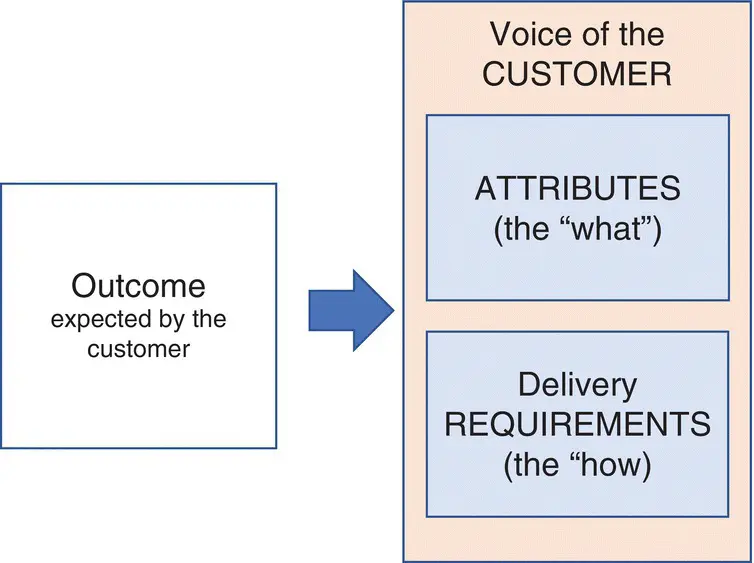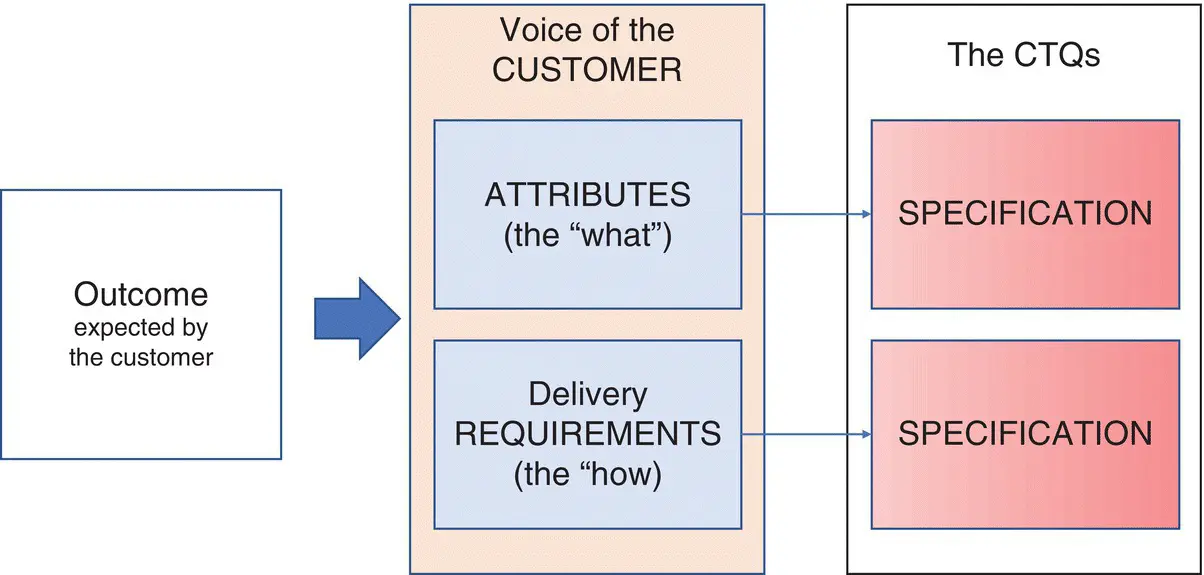The “What” and “How” of the Voice of the Customer
Patients, providers, and staff are the customers of our healthcare processes. They expect an outcome (VOC). The outcome must have certain attributesand must be delivered within certain requirements. The VOC therefore has two distinct components (see Figure 8‐2):
1 The “what” (attributes). This is the needed outcome, and the attributes of the outcome the customer (patient, provider, or staff) expects. A patient expects an “effective treatment,” “clear instructions,” and “clean facilities.” Alternatively, when a physician is the customer of a process, he or she might expect an “accurate diagnosis,” a “centered chest X‐ray,” or the “correct demographic information.”
2 The “how” (requirements). These are the requirements that characterize the outcome (output). Patients expect care delivered “on‐time” or in a “culturally sensitive” manner. Physicians would expect a chest X‐ray (needed outcome) to show up in the EMR “in a timely fashion,” and the radiologist’s official reading to be “easily found in the EMR.”

FIGURE 8‐2The outcome expected by the customer (VOC) is defined by attributes and requirements.
The customer (patient, staff, or provider) defines quality by identifying
the needed (expected) outcome.
the attributes of the outcome, and
the requirements that characterize the outcome.
Fulfilling the attributes (the “what”) and requirements (the “how”) of the VOC results in customer satisfaction. Achieving customers’ satisfaction is the ultimate goal of the QI project.
HOW DO WE COLLECT THE VOC?
Interviews
Interviews allow QI teams to get qualitative information about the needs and preferences of customers. Speaking to people that are the end users of the process and experience the problem can help us gain valuable information about the nature of the problem. It allows us to learn what the customer deems important and helps create a clear image about the customer’s needs and expectations. Interviews with the customers should be conducted at the beginning of the project to understand the issues. Interviews can also be conducted in the middle of a project to clarify important points, better understand the problem, or test potential ideas with the customers. Before conducting an interview, be clear about the what you are trying to achieve and the goal of the interview. Here are some steps you should take to maximize the return on investment of your interview.
Before the interview:
Select your customer’s segment carefully.
Decide on the criteria you are going to use for selecting interviewees.
Prepare a list of questions.
Decide on the interview method (face‐to‐face, phone, other).
Set an appropriate time and place.
During the interview:
Introduce yourself.
Clearly define the purpose of the interview.
Get consent if needed.
Listen carefully and take good notes.
Practice active listening.
Collect additional information about the customer if needed.
Thank all participants when done.
It’s best to get the VOC in person; talking to patients, staff, or providers at the time and location where they receive the end product of the process, whether that be receiving care (patients), or what they need to perform their work (staff and providers). If this is not possible, try to fund other alternatives that get you as close as possible.
One type of interview is a focus group. A focus group is a gathering of a selected number of people from the population of interest who participate in a facilitated discussion intended to elicit their opinions and perceptions about a particular issue or service. A focus group allows guests to interact. The format is flexible and follows a loose structure. It allows different groups to be invited around a single area of interest.
A survey provides quantitative and qualitative information about a large population of customers. A survey can also be used as preliminary tool to gather information and identify a target population, and subsequently conduct an interview. When preparing a survey, we recommend these steps:
1 Develop the objectives.
2 Calculate the sample size. Use standard formulas as needed (you can easily find them online).
3 Draft each question and determine the measurement scale. Numeric scales are often easier to work with but qualitative scales are sometimes needed. If necessary, include a “not applicable” category.
4 Determine how you are going to code the survey to maintain anonymity.
5 Make sure you conduct a pilot to assure the questions probe the correct issues and the answers are appropriate to the questions. Nothing is more disappointing than to find the survey you worked hard to design and administer is not fulfilling its purpose.
6 Decide how you will send the survey (email, mail, fax, download from web page, etc.).
7 Decide on the timeline and how you are going to get the surveys back.
Questionnaires designed in the United States may not be valid when applied to patients from other countries, as there may be disparities in patient expectations and cultural biases .
When direct methods for soliciting feedback are not available, indirect ways such as emails, phone interviews, or letters can be used to ensure that the needs and expectations of the customers are known.
CRITICAL‐TO‐QUALITY (CTQ)
What are the CTQs?
Patients, providers, and staff are customers in our healthcare processes. They expect an outcome:
The outcome must have certain attributes and must be delivered within certain requirements (VOC).
The customer also defines the specifications for both the attributes and requirements of the final outcome.
Patients know what they mean when they say that something is “good.” Our job is to help translate their statement into specific attributes and requirement that can be measured, tracked, and improved.
The customer (patient, staff, or provider) defines quality by identifying the outcome, the attributes of the outcome, and the requirements that characterize the outcome. The customer also defines the specifications for both the attributes and the requirements.
Patients’ needs and expectations are at times vague and nondescriptive. Specificity is needed to address the identified gaps between our current performance and the needs of our customers. A method designed to focus on the critical issues needed to achieve customers’ satisfaction with the outcome involves developing Critical‐to‐Quality (CTQ) requirements, or CTQs.
The CTQs are key measurable characteristics of service or care whose performance standards or specificationsmust be met in order to satisfy the customer (see Figure 8‐3).

FIGURE 8‐3The CTQs are the specifications of the Voice of the Customer
The CTQs translate general and difficult‐to‐measure customer needs or desires into very specific and measurable attributes and requirements of customer satisfaction. The CTQs are the quantifiable expectations of the customer.
Patient or customer needs and expectations come in all forms, shapes, and length of detail. Before we can move forward, these expectations need to be identified, organized, and understood. The CTQs help with this important task. The CTQs translate the broad needs and requirements of the customer (patients, staff, and providers), the VOC, into specific, actionable, and measurable performance attributes and requirements that provide direction for the project’s goals and activities.
Читать дальше














